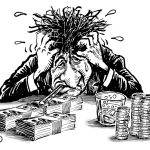Crazy Tokens
Would NFTs be the tulips of the XXIe century?
The Frans Hals Museum in Haarlem in the Netherlands, houses a work by the painter Jan Brueghel the Younger, satire of the “Tulipomania” of 1637, where monkeys, elegantly dressed, parody the tulip trade and engage in all kinds of human activities – and follies. Several centuries away, we remain amazed by the recent craze – at several tens of millions of dollars – for virtual performances of “CryptoPunks”, or “bored monkeys”, which have been the stars of the latest sales of the most prestigious auction houses. Boosted during the pandemic, the virtual world of online games, avatars and their accessories, the Metaverse is growing and forms an ecosystem, that is gaining more and more followers measuring its many successes in hundreds of billions of dollars.
The world of crypto assets is taking off. The NFT1,Non-Fungible Tokens, are distinguished by their uniqueness and popularity among those who are nicknamed the “crypto rich”. The art world is fond of it. They have caused the price of Ethereum to soar in recent months. Sports stars – Lionel Messi not to name him – are partly paid in this way. Since the beginning of the year, the crypto market has jumped by more than 170%2. Bitcoin makes it possible to buy real goods, it can serve as collateral for loans. It is now legal tender in El Salvador. The regulator is becoming more and more open about this.
The search for yields in the face of the inexorable fall in interest rates leads to all speculation.
Last week, the governors of the Bank of Sweden and the Bank of Mexico warned of the dangers of private currencies – “quick to collapse”, and which would only be a kind of “barter” without possessing the virtues of a real currency. The SEC3 also intends to regulate exchange platforms, while a market for loans collateralized by cryptoassets (including bitcoins) is being organized between individuals.
In El Salvador, bitcoin, although much decried, is now legal tender alongside the dollar. Is this a new bimetallism? If so, which of the two is the bad money that will drive out the good one, thus following Gresham’s immutable law? Elsewhere, the search for yields in the face of the inexorable fall in interest rates is pushing for all speculation, while central banks show no eagerness to get out of quantitative “over-easing”.
In China, bitcoin “miners” have been hunted, the youngest forced to drastically limit their video game time; elsewhere, regulators are active, both in terms of supervision and in terms of the virtual currency of central banks. And all speak of a new Wild West, conjuring up images of a lawless world.
Let us stay on this allegory, to recall that during almost the entire nineteenth century, the United States experienced a decentralized monetary and financial system without a Central Bank – this one disappeared in 1837 will not be reborn until 1913 – where a multitude of dollars issued by local banks flourished. Monetary instability and periods of inflationary and speculative fever were then almost endemic.
Faced with the growing appetite for all kinds of assets – from the strongest to the most virtual – when will a new “Volker moment4“ arrive, and what will be the consequences for the real-world economy?
1 NFT, Non-Fungible Token
2 Estimate given by Forbes magazine
3 The policeman of the American stock exchange
4 “Volker moment” describes the decision taken from 1979 by the new President of the Fed Paul Volker to raise the key rates of the Central Bank and to “break” the inflationary spiral of the moment.
Valérie Plagnol – Sep 2021 – Published in French in www.allnews.ch – Cartoon ©Barret



